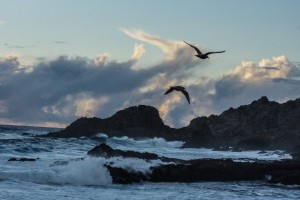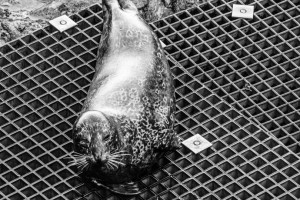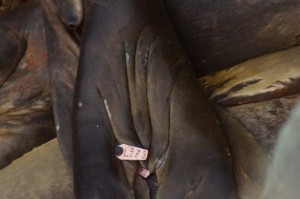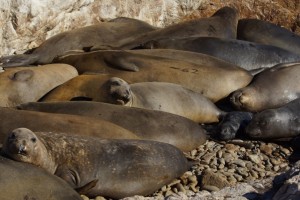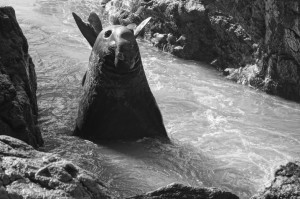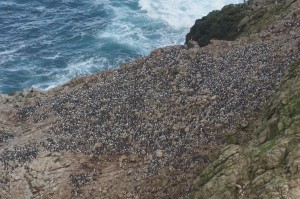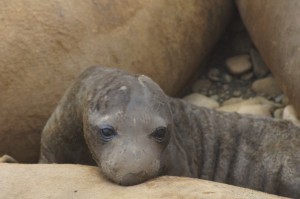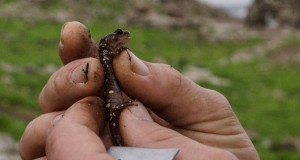In 2014 we had 14 amazing interns join us for various parts of the season (April-October). Most of these will have been seeking experience to forward their careers in marine biology in one form or another. Straight after volunteering with us for the last period of the season, James Robbins dashed off to the Pacific for another adventure. He’s taken some time out to write a guest blog for us from the Farallon Islands…
The Farallon islands are a small set of islands approximately 30 miles off the coast off San Francisco, and 2 miles from the continental shelf edge. This area is highly productive and hosts a diverse range of wildlife, both in the water and out. The islands are protected by the federal government, and are surrounded by a marine protected area. The average number of residents on the island is 4, all researching the wildlife which shares the island. I am one of those researchers, currently living and working on south-east farallon. I have come here after volunteering with Seawatch Foundation in New Quay last September, moving on from researching bottlenose dolphins to other species.
The research on the farallones is divided up into seasons, with spring and summer being occupied with hundreds of thousands of breeding sea birds, which leads into the autumn season researching song birds and white sharks. This brings us to the current season focussing on marine mammals from December to late March. Our primary research is on northern elephant seals, which give birth and breed in this time, and pups are weaned from the cows. Our typical day involves going down into the elephant seal colony to figure out which individuals have arrived, departed, moved, pupped, or lost their pup. This can take some time with 70 cows and 50 pups, but to help us we read tags in their flippers if present to track individuals throughout the years, and temporarily mark them to track them easily throughout the season. To mark them we use hair dye to either draw a number directly onto them, or use a pole to stamp it on. Using the stamp is often easier, especially in tightly packed areas, however writing on them whilst they are looking away or asleep is considerably less stressful, so we try to use that approach as much as possible. This approach works well, but is markedly different to those employed by SWF and many other researchers in the UK, which often use non-invasive techniques. These different techniques often use photo-identification to match pelage patterns of seal individuals to those in a catalog, similar to identifying individual dolphins by matching dorsal fin shape and scars. The target species is very different however, and each method has its benefits and suitable uses.
For example, harbour seals (a common target for photo-id in the UK) have clear individual markings which can be matched to databases, and they are incredibly skittish when disturbed. Elephant seals however have a more uniform colouration, and rarely move when they encounter humans, opting for staying still whilst vocalizing. As such it is easier to apply tags or stamps to these animals without considerable impact caused by moving the animals which may result in a loss of a pup or decreased nursing time.
Keeping track of male movement and success is also important. We have two main harems of cows, and two harem masters, Pete and Andre. Andre is a full-size bull, and Pete is a sub-adult stage 4, the size class before reaching bull-hood. Andre has his pick of the cows, and Pete will hold his territory from other males, until Andre shows interest and then he will run away, knowing he is likely to lose a fight to a larger male. Not long after Andre moves into a new spot, Pete will take the place left vacant, and they have swapped harems many times throughout the season.
Despite the majority of our time being spent in the elephant seal colony, we find time to conduct varied research, ranging from song bird, shore bird and gull surveys, to taking censuses of arboreal salamander populations, documenting the presence of cetaceans (whales, dolphins and porpoise) in the area, or counting the numbers of other pinnipeds on the island (California sea lions, stellar sea lions, harbour seals, and northern fur seals).
Living on an island in the Pacific has its quirks and challenges, which have been addressed and improved throughout the years. We collect and filter rain water for showers, drinking and washing up, and solar energy gives the generators a helping hand. As California is in a prolonged drought, rain water is rare and so showers are rationed to once every four days, for four minutes at a time. I have become used to this, but that isn’t to say that shower days are not something to look forward to! We rely on boat captains who volunteer their time and fuel to ship food to us every 2 weeks, which is landed at one of two locations, either being passed from a zodiac to a platform, or lifted up by crane from the water, as the seas are too rough for permanent dock fixtures. These landings are a lot of work, logistically and physically, but it is well worth it as I have eaten better here than anywhere else. We keep a fully stocked kitchen, which definitely helps morale. I am enjoying my time on the island immensely, and look forward to watching the pups weaning, but it will be sad to say goodbye to the island and the incredible diversity it is home to.
To read more about my experiences and to see many more photos, check out my personal blog at : http://naturesfreedom.blogspot.com/
And the farallon blog, which covers the research effort year-round : http://losfarallones.blogspot.co.uk/
Thanks to James for this fascinating insight and keep up the good work!

